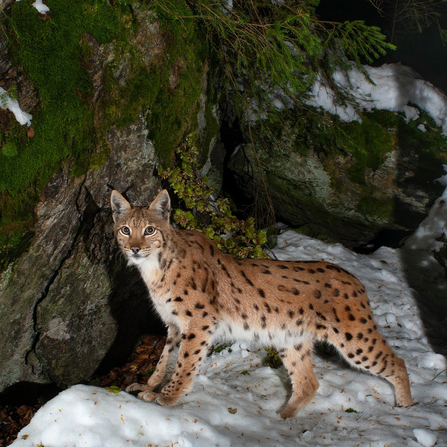
Image by Berndt Fischer.

Image by Berndt Fischer.
A year-long social consultation has found that 72% of people in the project area of Northumberland, bordering areas of Cumbria and southern Scotland, support potential lynx reintroduction. Lynx used to live in Britain until the medieval period when they died out due to hunting and habitat loss.
The consultation was run by The Missing Lynx Project, led by The Lifescape Project in partnership with Northumberland Wildlife Trust and The Wildlife Trusts. The consultation report provides the initial findings of local people’s attitudes towards lynx reintroduction and their level of support.
Now the project is working with people in the region to discuss how a potential reintroduction could be managed if it were to progress further. The partners are also urging people across the UK to find out more and have their say through a national questionnaire.
Over a thousand people in the project area filled in a detailed questionnaire in the project area. The regional consultation – which is ongoing – included:
The results coincide with the publication of a new peer-reviewed paper produced by the project, ‘Exploring the ecological feasibility of restoring Eurasian lynx to Great Britain using spatially explicit individual-based modelling’.
This research shows that a release of 20 lynx over several years into the Kielder forest area would, over time, create a healthy population of about 50 animals covering north-west Northumberland, the edge of Cumbria and the bordering areas of southern Scotland. It also reveals this is the only area of England and Wales with enough extensive woodland for lynx to thrive.
Dr Deborah Brady, project manager and lead ecologist, The Lifescape Project, says:
“We’d like to thank the thousands of people who visited the exhibition, filled in the questionnaire or spoke to us over the last year. Now we know that the majority of local people support lynx reintroduction and we also have the scientific evidence showing that a release of lynx in north-west Northumberland could work.
“We will continue to work with local communities to consider how a reintroduction project could be managed to maximise benefits and reduce risks. We hope to apply for a licence but only once we have a plan that’s collaboratively designed with local people which sets out measures that are acceptable, feasible and can be implemented.”
Mike Pratt, chief executive of Northumberland Wildlife Trust, says:
“The fact that 72% of respondents in the project region support a potential lynx reintroduction is hugely positive. Locals are proud our region is a stronghold for threatened species such as red squirrels and water vole – so it’s no surprise that they’re in favour of bringing more back. The chances of ever seeing this beautiful creature are very rare, but communities have let us know that they recognise the benefits of restoring this beautiful animal.”
Dr Rob Stoneman, director of landscape recovery, The Wildlife Trusts, says:
“Bringing back lynx could benefit wildlife more widely – something that is sorely needed in this nature-depleted country. We have pushed many native species to extinction, and it makes sense to bring missing wildlife back where feasible. Bison and beavers have invigorated degraded habitats and this consultation shows there’s now an opportunity for us to bring back lynx too.”
In addition to extensive interviews and workshops with key stakeholders, the project took a group of local farmers to Europe to visit two lynx projects and livestock farmers already living alongside lynx. One of those on the trip, Lauren Harrison, a sheep farmer from Hadrian’s Wall says:
“I saw in Europe that it’s possible to live alongside lynx. The risks to livestock can be minimal and there are so many positives. Tourism is an obvious one, but I also think a more balanced ecosystem is beneficial to farmers.
“I’ve been really impressed with the approach and the professionalism of the Missing Lynx Project - I think it’s really setting the standard for reintroduction projects. Consultation has been at the heart of everything they do: they have really listened and are still keen to work with farmers to make sure any reintroduction is well managed. I’d urge other farmers to engage with them and take some ownership of the project. The wider public clearly supports a lynx reintroduction and this is a great chance to help make it happen with so little risk to our businesses.”
Adam Eagle, chief executive of The Lifescape Project
“We are so excited to hear the views of people across the UK through our national survey, which is now open for responses from people everywhere. But we also know that some people will have concerns, so it is important that everyone has the chance to express a view. The possible return of this beautiful cat is such an important topic for nature restoration in the UK, with the potential to capture imaginations and become a catalyst for engaging people in nature.”